.jpg )
When people think of doing the big lap they typically think one of two things.
The grizzled grey nomads, skin beaten by a lifetime of adventures, retirement funds cashed in, inheritance sunk into diesel and a slow ambling lap around the continent stopping off at all the places they never got to the first time. The other thing that springs to mind is the young adventure family.
Raised on a diet of Steve Irwin and The Wild Thornberrys, they’ve packed it in for a life on the road before the kids hit school, the last taste of freedom before facing a 30-year slog in a mortgage.
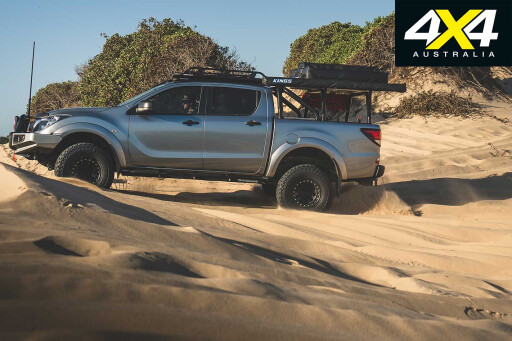 They’re both the perfect way to see Australia, and something more and more of us are doing every year. But Kane doesn’t think that way, he’s a little freer spirited.
They’re both the perfect way to see Australia, and something more and more of us are doing every year. But Kane doesn’t think that way, he’s a little freer spirited.
Despite lining his immaculate BT-50 up for a shoot just north of Sydney, he’s now a fair chunk farther north. Somewhere between Bundy and Mackay, with a few hundred kilometres between him and the closest thing resembling a city.
Despite only being 22, Kane figured there’s no time like the present, so he built the right vehicle, roped in a mate, and started circumnavigating one of the most remote continents in the world. By the time Kane’s BT ambles its way through Sydney again it’ll no doubt be sporting more than a few new battle scars and endless red dirt inside and out, but, for now, the set-up to see Australia is far simpler than you might expect.
The foundation for everything Kane’s done is his 2016 BT-50 dual cab. “I’d been eyeing off the Rangers,” he tells us with all the urgency of a man with no alarm clock. “After pricing them up, I figured I could get the same spec in the BT and put $13,000 into mods for the same price. Now, I’ve spent some time with it I actually prefer the look of the BTs as well.”
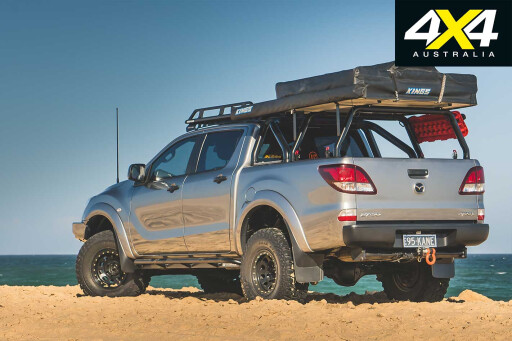 So what does $13,000 worth of mods look like? While lift and tyres grab attention, Kane reckons the must-have modifications so far have been the bar-work. “I don’t want to have to turn around because the track gets too gnarly,” Kane says with a laugh. “I built it to get me where I want to go without breaking shit.”
So what does $13,000 worth of mods look like? While lift and tyres grab attention, Kane reckons the must-have modifications so far have been the bar-work. “I don’t want to have to turn around because the track gets too gnarly,” Kane says with a laugh. “I built it to get me where I want to go without breaking shit.”
Kicking off the protection package up front is none other than the venerable ARB bullbar. The colour-coded Sahara unit blends in seamlessly with the BT’s lines, and, with the blacked-out top hoop, provides ample protection for the radiator against rural animal strikes. The ARB’s bash plates line up with the factory offerings underneath to protect the BT’s unmentionables all the way back to the gearbox.
The ability to self-recover is a get-out-of-gaol-free card when solo travelling, so Kane’s stuffed the ARB bar with a 12,000lb winch and synthetic rope. Also nestled within the top hoop are a pair of Narva Ultima 225 HID lights.
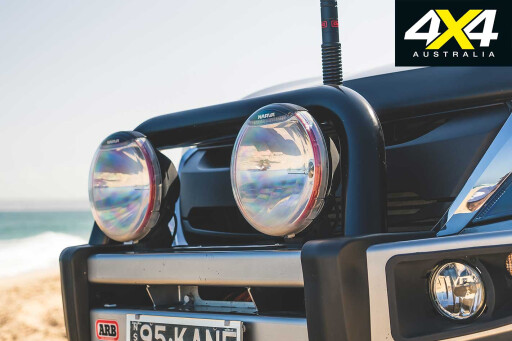 Moving down the flanks of the BT and the vulnerable sill panels have been beefed up, thanks to a combination of round and box tube from the guys at Southern Cross Fabworks in the form of their angled-up sliders. While they double as a sidestep they’re also a handy high-lift jacking point and have already glanced off countless rocks and ruts.
Moving down the flanks of the BT and the vulnerable sill panels have been beefed up, thanks to a combination of round and box tube from the guys at Southern Cross Fabworks in the form of their angled-up sliders. While they double as a sidestep they’re also a handy high-lift jacking point and have already glanced off countless rocks and ruts.
Up top the black-on-silver theme continues. Kane’s fitted up a Rhino-Rack Tradies rack for additional storage when the tray and back-seat are bursting with tea-towels from the croc-tent. It’s mounted on their slim-line Backbone System that braces the rack against the full length of the roof and looks horn in the process.
While the tub’s quarter panels remain vulnerable for now, it’s above where it really shines. With the factory roll bar blacked out, Kane turned his attention to a rack for his set-up. The unique arrangement takes advantage of two stock sports bars modified into something fit for the big lap.
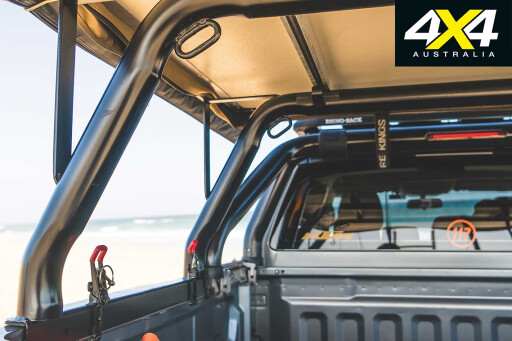 The set-up clamps on and off with a few over-centre latches, letting Kane go from overland travel mode to dirt bike in the back in just a few minutes. The rack not only holds the standard fitment roll-out awning, but it also sports a roof-top tent. There’s a set of Treds mounted along the driver’s flank, too, if Kane’s ambitions outweigh his talents.
The set-up clamps on and off with a few over-centre latches, letting Kane go from overland travel mode to dirt bike in the back in just a few minutes. The rack not only holds the standard fitment roll-out awning, but it also sports a roof-top tent. There’s a set of Treds mounted along the driver’s flank, too, if Kane’s ambitions outweigh his talents.
Of course, standard rolling stock will last about 300 metres when the going gets seriously tough, so Kane’s thrown the silver beauty up on a hoist and gone to town.
The most noticeable upgrade is the chunky Baja ATZ P3 tyres. Mickey Thompson’s relatively new aggressive all-terrain is the perfect companion for the big lap and, coming in a hair under 33 inches at 285/75R16, provides Kane with an extra few inches of clearance under the diffs. He’s wrapped them around a set of 0-offset 16-inch Dynamic D-lock steel wheels with a clip-on steel ring protecting the tyre’s bead.
 Now tyres that size were never fitting inside the wheel arches at standard height, not unless they were persuaded with a ball-pein hammer. Rather than taking to his new ute like Tony Soprano in a dimly lit laneway, Kane instead opted for a 50mm lift all-round.
Now tyres that size were never fitting inside the wheel arches at standard height, not unless they were persuaded with a ball-pein hammer. Rather than taking to his new ute like Tony Soprano in a dimly lit laneway, Kane instead opted for a 50mm lift all-round.
Up front, mono-tube Bilstein struts swap out the stock offerings and provide a much improved ride over stock, with plenty of grunt to take on endless corrugations. They’re shod in heavy-duty coils from CalOffroad, perfectly matched to the exact weight of the BT’s nose. Up the back Kane’s opted for another set of Bilstein’s finest, this time they’re controlling a set of comfort-rated EFS leaf springs.
Kane has taken that less-is-more approach to everything in 2018: the interior is standard, shy of a dual-battery set-up and GME UHF; the drivetrain is stock, with just a Fabulous Fab snorkel; and the calendar is free.
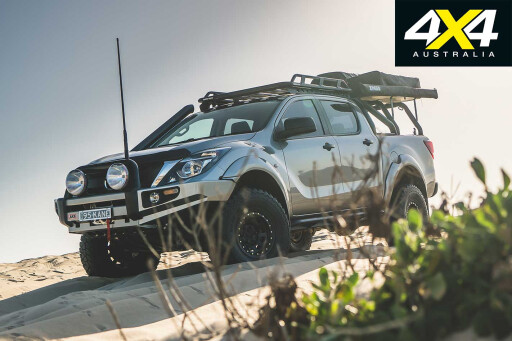 “We’re just heading north, all the way to the tip,” Kane tells us. “If we come out without anything too broken we’ll head across the Savannah Way over to Darwin.”
“We’re just heading north, all the way to the tip,” Kane tells us. “If we come out without anything too broken we’ll head across the Savannah Way over to Darwin.”
Six months from now Kane could be rolling into Perth or working on a fishing boat in the Gulf; he doesn’t know and that’s what’s inspiring. When we’re all constantly told you can’t head off for a weekend on the tracks without $150,000 worth of 6x6 conversions, Kane’s turned his phone off and headed off to do it his own way.
Less is More
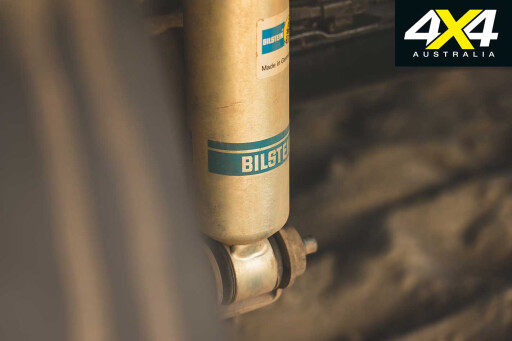 THE term mono-tube is a term that doesn’t accurately describe the differences between twin-tube and mono-tube shocks, and what’s better for your needs. A shock absorber works by pushing a piston with small holes in it through oil. The harder for the piston to move through oil, the stiffer the shock.
THE term mono-tube is a term that doesn’t accurately describe the differences between twin-tube and mono-tube shocks, and what’s better for your needs. A shock absorber works by pushing a piston with small holes in it through oil. The harder for the piston to move through oil, the stiffer the shock.
Mono-tube shocks have a second piston keeping pressure on the oil with high-pressure gas on the other side. That piston keeps the oil pressurised, stopping it from foaming and passing through the piston easier (shock fade). The design fits inside one solid tube, so it loses heat quicker (perfect for corrugations) and gives you more dampening force for the thickness of the shock.
Traditional twin-tube shock absorbers have an outer sleeve with low-pressure gas trying to control the oil. They’re more prone to fade but considerably cheaper. Without a second piston in line they typically have longer travel for the same overall length; the outside tube also gives a layer of protection from dents stopping the piston working.

COMMENTS